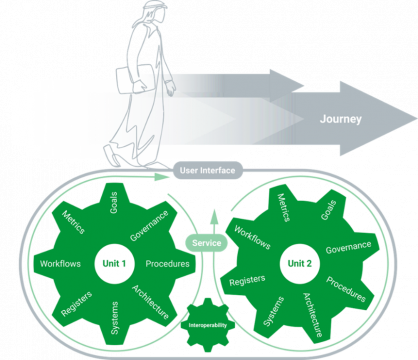Article
The devil's in the data: Shaping a seamless journey for citizens
Data is the public sector’s Achilles heel and the source of significant opportunity. The public sector cannot function without the data of its country’s citizens. Still, inefficient or ineffective collection and use of that data is also the biggest source of complaint – not to mention the risks surrounding data privacy. Data is why the public sector exists, but it’s also its most significant vulnerability.
This very point was raised in a famous episode of the BBC television series Yes Minister when the Secretary of State for Administrative Affairs, Jim Hacker, asked his private secretary for suggestions on making his department more popular. The best Sir Humphrey could do was an advertising slogan: Red Tape Holds a Nation Together, or Administration Saves a Nation.
Sir Humphrey was essentially correct – red tape does hold a nation together. But the fact that the public sector lives with the inevitable ‘red tape’ label reveals its problem; it’s seen as unnecessary, wasteful, and widely detested.
In this blog, the first in a series exploring the foundations of a seamless digital society, we focus on how data and registers can improve government services.
Key takeaways:
- Registers, and the data contained in them, are the foundation of journey-based proactive government services.
- Data needs to be interlinked and registers designed from a digital perspective.
- Regulation needs to ensure data quality and transparency, as well as buy-in from people.
- Technology can accelerate change, but it is not enough in itself.
Proactive rather than reactive
Digitalizing the public sector allows us to create a seamless society that works in favor of its citizens – a system that actively makes people’s lives better rather than burdens them with frustrating administration and endless form-filling.
Such a system must be proactive rather than reactive, where citizens are asked if they want or need a particular service based on analysis of their data rather than forced to apply for every individual thing (and be aware of every assistance and support on offer). This approach creates an equal system for all taxpayers – none are excluded because they cannot navigate government administration or are unaware of their rights.
One way of optimizing digital public services is the journey-based approach – re-designing services based on life events. But life-event services can only be done meaningfully if data quality is good. If data quality and how data gets into registers are faulty, then a journey-based approach cannot be delivered proactively and seamlessly.
Devil is in the data
Registers and data contained in them are the foundation of this system. There are around 10 core registers in every country (including population, business, and land), which must be first-rate for this approach to work. They are the basis for meaningful interoperability and critical for the “once only” principle of successful implementation, which is the core principle for journey-based services. (Standardization of core registers will become the norm, incidentally, but this does not mean that they can or will be copied and pasted from each other. Registers can be similar to an extent, but the devil is in the details.)

Rich data is already collated in various government registers in most countries, but these are rarely connected to each other. This means that citizens must re-enter their information at every interaction with the government, that relevant information is not being shared between functions, and that discrepancies and errors in data are difficult to spot and correct.
Design from a digital perspective
The answer is the interlinking of data in registers. If data is shared, information required for different services can be filled in automatically – and data analysis would allow governments to proactively offer the proper support and services to the right people at the right time. If there is no interoperability in public sector registers, there cannot be any fundamental change towards a journey-based approach and a seamless public services experience.
Achieving this system means designing the entire system (processes and regulations) from a digital perspective; it is generally not a good idea to create a good outcome by trying to adapt the existing and outdated regulatory system to a digital world. It will just repeat the same mistakes, but digitally.
Who holds which rights
This isn’t as fundamental a shift as it may sound. The basic purpose of a register is to understand who holds which rights. Permissive use is the cornerstone of modern government. A country’s regulatory environment defines the type of data, why it is collected, and how it can be used. However, these regulatory frameworks often date back 70+ years and are outdated in their objectives.
Regulatory innovation is difficult because no country can function in a bubble. Whatever procedural innovation in registry keeping is introduced must comply with international logic and the rules dictating legal certainty. Societal change must be based on legal certainty because legal certainty ensures data quality and drives trust toward the reliability of public services.
Whatever is done on the system level comes down to regulation and buy-in from people. Transparency, legal certainty, and decision-making logic are the pillars of a trustworthy digital government. There are many use cases worldwide on how nations have tackled these aspects. While there are many possible approaches, in the end, user-centric design is at the heart of them all. Citizens must have control over their data or, at least, transparency concerning how it is used. National consent management tools and data trackers are just some of the tools that enable users to understand who has been viewing and using their data. These are all good measures but ones that require context to be truly useful.
Technology is not enough on its own
Technology can accelerate change, but it is not enough in itself. Take, for example, electronic signatures. The debate about the legality of electronic signatures continues to rage when the truth is that its legal status has been clear in U.S. law since the 1860s. In 1869, the New Hampshire Supreme Court decided in the case of Howley v Whipple that agreement to a contract sent by telegram was as binding as a signed paper. As the ruling put it: ‘It makes no difference whether the [telegraph] operator writes a steel pen an inch long attached to an ordinary penholder, or whether his pen is a copper wire a thousand miles long. Not does it make any difference that in one case common record ink is used, while in the other case a more subtle fluid, known as electricity, performs the same office.’
It is telling that we have been talking about digital signatures and the certainty of binary transactions for more than 140 years. Yet, there still needs to be an internationally agreed consensus. We must agree on the best underlying technology to use in each situation. Novel technologies can help us to overcome challenges posed by modern times, but applying novel technologies should be a weighted decision. Buzzwords tend to drive the tech world, which can create challenges rather than bring about genuine societal change.
To create a seamless digital society, we need to start with strong political will followed by regulatory and procedural change. That will define what data is collected, why it is collected, and how it is used. That means starting with a digital mindset – letting go of A4 thinking and thinking in terms of data instead. Otherwise, we risk an outcome where we aim for the best but end up with a slightly different version of the past.
Get in touch
Let us offer you a new perspective.


